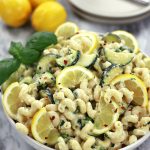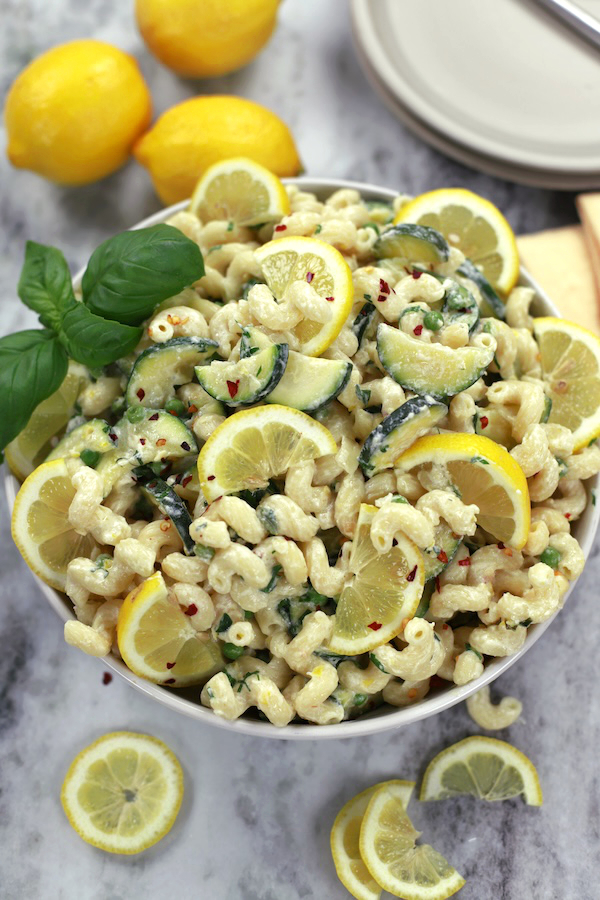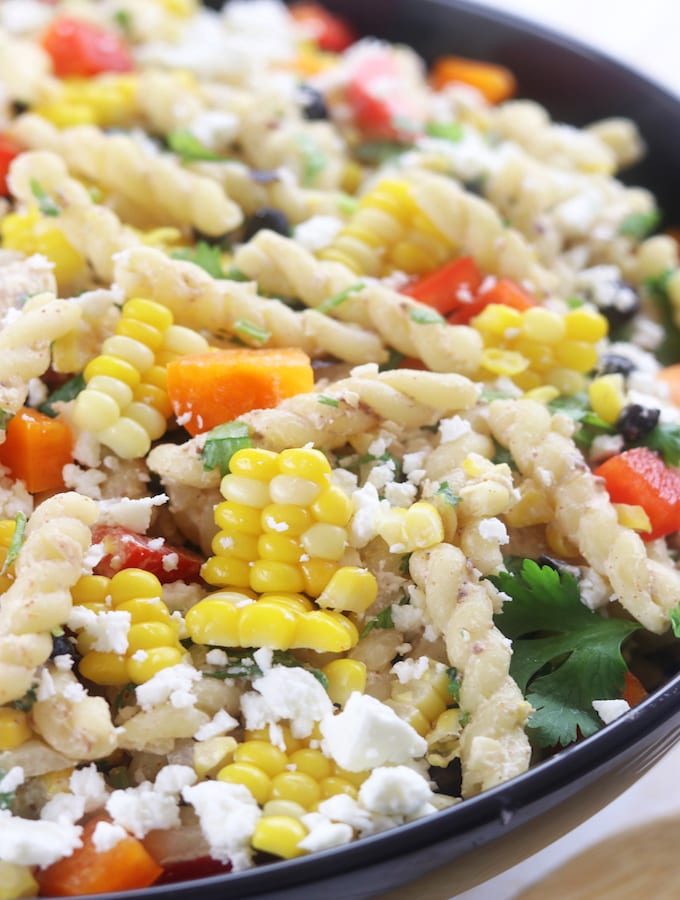Lemon Ricotta Pasta
Lemon Ricotta Pasta is a creamy, light and refreshing recipe that is easy enough for the beginner cook yet feels incredibly gourmet. The addittion of sautéed zucchini and sweet peas brings fresh and vibrant flavors. Included are options to switch up the veggies to match the season, making this pasta dish perfect for summer evenings or holiday celebrations.
This post may contain affiliate links which I earn a small portion in sales if a purchase is made. Rest assured though, it is never at any additional cost to you.

The Unique Appeal of Lemon Ricotta Pasta
Have you ever struggled to find a dish that’s both simple to make and special enough for a memorable meal? Lemon Ricotta Pasta solves this common frustration. This recipe is bright, creamy, and satisfying, making it perfect for a summer evening or a special occasion like Christmas or New Year’s. Despite its gourmet feel, it’s incredibly easy to prepare. With fresh, vibrant flavors from sautéed zucchini and sweet peas, this pasta brings a touch of elegance to your table without the hassle of a complicated recipe.
Mastering a Creamy Lemon Ricotta Sauce
Lemon juice, being highly acidic, can cause milk proteins in ricotta to curdle by denaturing and coagulating them. However, when added at the end of the cooking process, lemon juice balances the richness and enhances the flavors of this pasta dish while preventing curdling. This timing ensures that the bright, acidic flavor shines through without compromising the texture.
Secret to Achieving a Bold Citrus Flavor
Lemon zest adds a bright, tangy flavor that enhances the creamy ricotta sauce. Its essential oils infuse a fresh, citrusy aroma, balancing the richness and adding complexity. This burst of lemony goodness makes each bite more vibrant and delicious.
Because a larger amount of lemon zest is being used for this pasta, using a vegetable peeler is an easy way to quickly and efficiently create larger zest strips. These strips really are the secret to achieving a delicious and bold lemon flavor.
Most Helpful Tools
- OXO Good Grips Swivel Vegetable Peeler– This peeler makes creating lemon zest strips incredibly easy.
- Garlic Press– Using a garlic press is one of the easiest ways to crush garlic.
- Spider Strainer– The easiest way to quickly and efficiently transfer pasta from the boiling water to the sauce without draining the entire pot.
- 12 Inch 6 Quart Skillet Pan– This sized pan is very much needed when making a larger pasta dish like this Lemon Ricotta Pasta.
- Knifes– Having quality knives makes cooking easier by allowing you to cut, chop, and slice with precision and ease, making your kitchen tasks quicker and safer. If you’re new to cooking, this brand is a great place to start because their knives are durable and affordable.
Ingredients Needed
- Pasta– Any pasta can be used for this Lemon Ricotta Pasta, but pasta with ridges holds the cream sauce more effectively. Some favorites are Cavatappi, Fusilli and Rigatoni.
- Extra Virgin Olive Oil– Blended with ricotta cheese, olive oil adds a silky texture and rich flavor, creating a smooth, creamy base that coats the pasta evenly.
- Brown Onion– Cooked until softened, the onion adds a subtle sweetness and savory depth to the sauce, forming a solid foundation for the other flavors.
- Garlic– Garlic adds a robust, aromatic kick and complexity that helps balance the richness of the ricotta.
- Zucchini– Sliced zucchini contributes a tender, slightly sweet texture and freshness, adding both flavor and color to the dish.
- Peas– Peas offer a pop of sweetness and a vibrant green contrast, bringing a burst of freshness and a hint of springtime to the pasta.
- Ricotta Cheese– Creamy and mild, ricotta creates a luscious, smooth sauce that binds the ingredients together while adding a delicate richness.
- Lemon Peel– Lemon zest adds a bright citrusy flavor and refreshing element to the sauce.
- Parmigiano Reggiano– This aged cheese adds a sharp, nutty depth to the sauce, enhancing its richness and bringing a sophisticated umami flavor.
- Basil– Fresh basil adds a burst of herbaceous freshness that beautifully complements the lemon.
- Salt and Pepper (to taste)– Essential for seasoning, salt enhances all the flavors, while pepper adds a subtle heat and depth, rounding out the dish.
- Reserved Pasta Water– This starchy water helps achieve the right sauce consistency and binds the ingredients together helping to make the sauce smooth and luxurious.
- Lemon Juice– The acidity of lemon juice balances the richness of the sauce and, when added at the end of cooking, helps prevent the ricotta from curdling.
How To Make Lemon Ricotta Pasta
- Cook the pasta according to package instructions, reserving 3/4 cup of the cooking water before draining.
- Zest the lemons and blend with ricotta cheese and 1/4 cup olive oil until smooth.
- In a skillet over medium-high heat, sauté the onion in 1.5 tablespoons of olive oil until softened. Add zucchini and cook until tender and slightly golden. Stir in peas and cook until warmed through. Remove vegetables and set aside.
- In the same skillet, add the remaining 1.5 tablespoons of olive oil, garlic, and red pepper flakes, sautéing until fragrant. Reduce heat to low, add the ricotta mixture and Parmesan cheese, and stir well. Gradually whisk in the reserved pasta water until the sauce reaches your desired thickness and is heated through.
- Add the cooked pasta and vegetables to the skillet, tossing to coat with the sauce. Turn off the heat and stir in basil, parsley and lemon juice. Season with salt and pepper to taste.
Fool-Proof al Dente Pasta Cooking Tips
- Use Plenty of Water– Fill a large pot with water to give the pasta space to cook evenly.
- Salt the Water– Add a generous amount of salt to enhance the pasta’s flavor.
- Follow Package Instructions– Cook the pasta according to the time suggested. Make sure to stir frequently and check on the pasta a few minutes before the suggested cooking time is up. A helpful tip, as the pasta nears doneness, the water will thicken slightly.
- Taste for Doneness– Sample a piece of pasta; it should be firm with a slight bite, not soft or mushy.
- Reserve Pasta Water– Before draining, save 3/4 cup of the pasta water. It’s useful for adjusting the sauce consistency and adding flavor.
Make It Your Own: Simple Ingredient Twists
- Proteins– Before sautéing the veggies, consider cooking proteins like shrimp, sausage, or chickpeas directly in the pan for added flavor. Grilled chicken or seafood also make excellent additions, infusing your dish with rich, savory flavors.
- Vegetables– You can customize this pasta with seasonal veggies: in spring, try asparagus and peas; in summer, go for yellow crookneck squash and corn; for fall, add roasted butternut squash and mushrooms; and in winter, kale, Brussels sprouts, or broccoli would be delicious additions.
- Cheese– For a twist, replace ricotta with feta, cottage cheese or mascarpone. Just make sure to blend in the same manner as the ricotta. Additionally, Pecorino Romano or Gruyere cheese would be a delicious substitute for Parmigiano Reggiano.
- Herbs– Thyme, rosemary, tarragon, dill, chives, and mint all make excellent alternatives to Italian parsley and basil. Add thyme and rosemary alongside the garlic to infuse their flavors early on. Reserve chives, tarragon, dill, and mint for the final moments of cooking or as a garnish to preserve their fresh, delicate notes.
Storing and Reheating
Storage– Allow the pasta to cool slightly before transferring it to an airtight container. Store in the refrigerator for up to 3 days.
Reheating– To reheat, gently warm the pasta in a skillet over medium heat, adding a splash of water or extra olive oil to restore the creamy texture. Stir frequently to prevent sticking. Alternatively, you can reheat it in the microwave in 1-minute intervals, stirring in between. Avoid reheating at high temperatures to prevent the sauce from separating.
Frequently Asked Questions
How do I prevent the ricotta from curdling when adding lemon juice?
To prevent ricotta from curdling when adding lemon juice, add the lemon juice at the end of cooking. This way, it enhances the flavor without causing the ricotta to separate.
Can I use other types of cheese in place of ricotta?
Yes, Cream cheese, mascarpone, or cottage cheese can work as alternatives. Each will give a slightly different texture and flavor, but they all can create a creamy, delicious sauce.
What type of pasta works best for this dish?
Pasta with ridges, like Rigatoni, Penne, Fusilli, or Cavatappi, holds the creamy sauce beautifully, ensuring each bite is flavorful and well-coated. However, as with many food choices, it comes down to personal preference.
Can I make this Lemon Ricotta Pasta ahead of time?
This pasta dish is best enjoyed freshly made, but you can save time by preparing some steps in advance, like chopping the onion and zucchini, and blending the ricotta, olive oil, and lemon zest.

Lemon Ricotta Pasta
Equipment
- vegetable peeler *XOX Good Grips makes peeling lemons very easy.
Ingredients
- 16 ounces pasta *see Note #1 below
Ricotta Mixture
- 16 ounces whole milk ricotta *low-fat also works.
- 1/4 cup extra virgin olive oil *blended with ricotta
- 3 medium lemons zested *removed with a vegetable peeler, see Note #2 below.
For the Vegetables
- 3 tablespoons extra virgin olive oil (divided) *for sautéing
- 1 medium brown onion (aka yellow onion) *finely chopped, about 1 1/2 cups
- 1 pound zucchini *thinly sliced into half-moons
- 1 cup frozen peas
- 4 cloves garlic *minced or crushed, approximately 1 tablespoon
- 1/4 teaspoon crushed red chili pepper flakes *optional
- 1/4 cup fresh basil leaves *chopped or torn
- 1/4 cup Italian Parsley *chopped
- 1 cup Parmesan Cheese *finely grated, see Note #3 below
- 3/4 cup reserved pasta water *see Note #4 below
- 2 tablespoons lemon juice
Instructions
Pasta
- Bring a large pot of salted water to a boil over high heat. Cook the pasta according to package instructions until al dente.
- Towards the end of cooking reserve 3/4 cup of pasta cooking water.
Ricotta Mixture
- Wash the lemons and use a vegetable peeler to zest them, avoiding the white pith.
- In a blender, combine the ricotta cheese, lemon zest, and 1/4 cup of olive oil. Blend until smooth and creamy. Set aside.
Vegetables
- While the pasta water comes to a boil, heat a large skillet over medium-high heat.
- Add 1.5 tablespoons of olive oil and sauté the onion until softened, about 3-5 minutes.
- Add the zucchini and continue sautéing until tender and slightly golden, about 4-5 minutes.
- Stir in the peas and cook until warmed through, about 2-3 minutes.
- Remove the vegetables from the skillet and set aside.
Prepare the Sauce
- In the same skillet over medium heat, add the remaining 1.5 tablespoons of olive oil. Add the garlic and red pepper flakes, and sauté until fragrant, about 1-2 minutes.
- Reduce the heat to low, then add the lemon ricotta mixture to the skillet and the parmesan cheese. Stir well.
- Gradually whisk in the reserved pasta water, a little at a time, until the sauce reaches your preferred thickness and is smooth and creamy. Ensure the heat is kept low to prevent curdling.
- Add the cooked pasta and sautéed vegetables to the skillet. Toss until the pasta is well coated with the sauce.
- Turn off the heat and stir in the chopped basil, parsley and lemon juice. Season with salt and freshly ground black pepper to taste.








